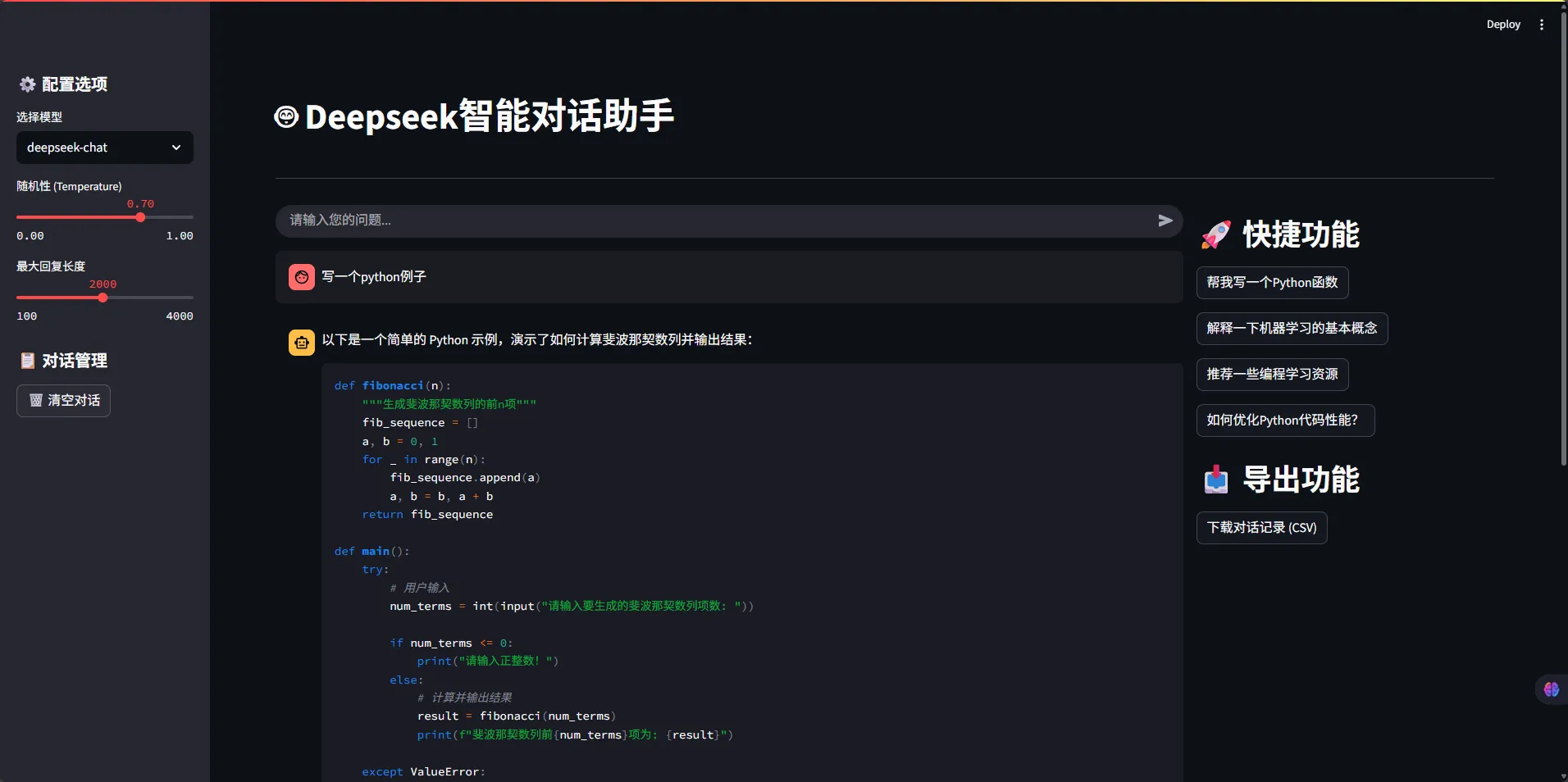目录
在AI大模型普及的今天,如何利用Python快速构建一个智能对话应用成为了许多开发者关注的焦点。Deepseek作为国内优秀的大语言模型,凭借其强大的推理能力和便捷的API接口,为Python开发者提供了绝佳的应用开发机会。
本文将手把手教你如何使用Python开发一个完整的Deepseek应用,从环境搭建到代码实战,再到优化部署,让你快速掌握AI应用开发的核心技能。无论你是Python初学者还是有一定基础的开发者,都能从这篇文章中获得实用的开发经验和最佳实践。
🔍 问题分析:为什么选择Deepseek?
💰 成本优势
Deepseek相比GPT-4等国外模型,在API调用费用上有着明显优势:
- 价格透明:按token计费,成本可控
- 免费额度:新用户通常有一定的免费调用额度
- 性价比高:在保证质量的前提下,成本仅为GPT-4的1/10左右
🎯 技术特点
- 推理能力强:在数学、逻辑推理方面表现优异
- 中文理解好:针对中文场景进行了深度优化
- API简单:接口设计简洁,易于集成
🌐 应用场景
- 智能客服系统
- 代码生成助手
- 文档问答机器人
- 教育辅导应用
💡 解决方案:Python开发架构设计
🏗️ 整体架构
Markdown┌─────────────────┐ ┌─────────────────┐ ┌─────────────────┐ │ 用户界面层 │ │ 业务逻辑层 │ │ 数据访问层 │ │ (Streamlit) │────│ (API调用) │────│ (数据库/文件) │ └─────────────────┘ └─────────────────┘ └─────────────────┘
🔧 技术栈选择
- 前端框架:Streamlit(快速构建Web界面)
- HTTP客户端:requests(API调用)
- 数据处理:pandas(对话记录管理)
- 配置管理:python-dotenv(环境变量管理)
💻 代码实战:构建你的第一个Deepseek应用
🚀 环境准备
首先,让我们安装必要的依赖包:
Bashpip install streamlit requests python-dotenv pandas
创建项目目录结构:
Pythondeepseek_app/
├── app.py # 主应用文件
├── config.py # 配置文件
├── deepseek_client.py # Deepseek API客户端
├── .env # 环境变量文件
└── requirements.txt # 依赖包列表
🔑 配置管理
创建.env文件存储API密钥:
textDEEPSEEK_API_KEY=your_api_key_here DEEPSEEK_BASE_URL=https://api.deepseek.com/v1
config.py配置文件:
Pythonimport os
from dotenv import load_dotenv
# 加载环境变量
load_dotenv()
class Config:
"""配置类"""
DEEPSEEK_API_KEY = os.getenv('DEEPSEEK_API_KEY')
DEEPSEEK_BASE_URL = os.getenv('DEEPSEEK_BASE_URL', 'https://api.deepseek.com/v1')
MAX_TOKENS = 2000
TEMPERATURE = 0.7
# 验证必要配置
@classmethod
def validate(cls):
if not cls.DEEPSEEK_API_KEY:
raise ValueError("DEEPSEEK_API_KEY 未设置,请检查.env文件")
return True
🤖 Deepseek客户端封装
deepseek_client.py:
Pythonimport requests
import json
from typing import List, Dict, Optional
from config import Config
class DeepseekClient:
"""Deepseek API客户端"""
def __init__(self):
Config.validate()
self.api_key = Config.DEEPSEEK_API_KEY
self.base_url = Config.DEEPSEEK_BASE_URL
self.headers = {
'Authorization': f'Bearer {self.api_key}',
'Content-Type': 'application/json'
}
def chat_completion(self,
messages: List[Dict[str, str]],
model: str = "deepseek-chat",
max_tokens: int = None,
temperature: float = None) -> Optional[str]:
"""
调用Deepseek聊天接口
Args:
messages: 消息列表
model: 模型名称
max_tokens: 最大token数
temperature: 随机性参数
Returns:
str: 模型回复内容
"""
try:
url = f"{self.base_url}/chat/completions"
data = {
"model": model,
"messages": messages,
"max_tokens": max_tokens or Config.MAX_TOKENS,
"temperature": temperature or Config.TEMPERATURE,
"stream": False
}
response = requests.post(url, headers=self.headers, json=data, timeout=30)
response.raise_for_status()
result = response.json()
if 'choices' in result and len(result['choices']) > 0:
return result['choices'][0]['message']['content']
else:
return "抱歉,我现在无法回答您的问题。"
except requests.exceptions.Timeout:
return "请求超时,请稍后重试。"
except requests.exceptions.RequestException as e:
return f"网络请求错误:{str(e)}"
except json.JSONDecodeError:
return "响应解析错误,请检查API接口。"
except Exception as e:
return f"发生未知错误:{str(e)}"
def stream_chat_completion(self, messages: List[Dict[str, str]], model: str = "deepseek-chat"):
"""
流式调用Deepseek聊天接口
Args:
messages: 消息列表
model: 模型名称
Yields:
str: 逐步返回的内容
"""
try:
url = f"{self.base_url}/chat/completions"
data = {
"model": model,
"messages": messages,
"max_tokens": Config.MAX_TOKENS,
"temperature": Config.TEMPERATURE,
"stream": True
}
response = requests.post(url, headers=self.headers, json=data, stream=True)
response.raise_for_status()
for line in response.iter_lines():
if line:
line = line.decode('utf-8')
if line.startswith('data: '):
data_str = line[6:]
if data_str.strip() == '[DONE]':
break
try:
data = json.loads(data_str)
if 'choices' in data and len(data['choices']) > 0:
delta = data['choices'][0].get('delta', {})
if 'content' in delta:
yield delta['content']
except json.JSONDecodeError:
continue
except Exception as e:
yield f"流式请求错误:{str(e)}"
🎨 Streamlit前端界面
app.py主应用文件:
Pythonimport streamlit as st
import pandas as pd
from datetime import datetime
from deepseek_client import DeepseekClient
# 页面配置
st.set_page_config(
page_title="Deepseek智能对话助手",
page_icon="🤖",
layout="wide",
initial_sidebar_state="expanded"
)
# 初始化客户端
@st.cache_resource
def init_client():
"""初始化Deepseek客户端"""
try:
return DeepseekClient()
except Exception as e:
st.error(f"初始化失败:{str(e)}")
return None
# 初始化会话状态
def init_session_state():
"""初始化会话状态"""
if 'messages' not in st.session_state:
st.session_state.messages = []
if 'chat_history' not in st.session_state:
st.session_state.chat_history = []
def main():
"""主函数"""
st.title("🤖 Deepseek智能对话助手")
st.markdown("---")
# 初始化
init_session_state()
client = init_client()
if not client:
st.error("❌ 无法连接到Deepseek服务,请检查配置")
return
# 侧边栏配置
with st.sidebar:
st.header("⚙️ 配置选项")
# 模型选择
model = st.selectbox(
"选择模型",
["deepseek-chat", "deepseek-coder"],
index=0
)
# 参数调整
temperature = st.slider("随机性 (Temperature)", 0.0, 1.0, 0.7, 0.1)
max_tokens = st.slider("最大回复长度", 100, 4000, 2000, 100)
# 对话历史管理
st.header("📋 对话管理")
if st.button("🗑️ 清空对话"):
st.session_state.messages = []
st.session_state.chat_history = []
st.success("对话已清空")
# 显示对话统计
if st.session_state.messages:
st.info(f"当前对话轮数:{len(st.session_state.messages)//2}")
# 主对话区域
col1, col2 = st.columns([3, 1])
with col1:
# 显示对话历史
chat_container = st.container()
with chat_container:
for message in st.session_state.messages:
with st.chat_message(message["role"]):
st.markdown(message["content"])
# 用户输入
user_input = st.chat_input("请输入您的问题...")
if user_input:
# 添加用户消息
st.session_state.messages.append({"role": "user", "content": user_input})
# 显示用户消息
with st.chat_message("user"):
st.markdown(user_input)
# 生成回复
with st.chat_message("assistant"):
message_placeholder = st.empty()
# 准备消息格式
messages_for_api = [
{"role": msg["role"], "content": msg["content"]}
for msg in st.session_state.messages
]
# 流式生成回复
full_response = ""
for chunk in client.stream_chat_completion(messages_for_api, model):
full_response += chunk
message_placeholder.markdown(full_response + "▌")
message_placeholder.markdown(full_response)
# 添加助手回复
st.session_state.messages.append({"role": "assistant", "content": full_response})
# 保存到历史记录
st.session_state.chat_history.append({
"timestamp": datetime.now().strftime("%Y-%m-%d %H:%M:%S"),
"user": user_input,
"assistant": full_response,
"model": model,
"temperature": temperature
})
with col2:
# 快捷功能
st.header("🚀 快捷功能")
# 预设问题
preset_questions = [
"帮我写一个Python函数",
"解释一下机器学习的基本概念",
"推荐一些编程学习资源",
"如何优化Python代码性能?"
]
for question in preset_questions:
if st.button(question, key=f"preset_{question[:10]}"):
st.session_state.messages.append({"role": "user", "content": question})
st.experimental_rerun()
# 导出对话记录
if st.session_state.chat_history:
st.header("📥 导出功能")
# 转换为DataFrame
df = pd.DataFrame(st.session_state.chat_history)
# 提供下载
csv = df.to_csv(index=False, encoding='utf-8-sig')
st.download_button(
label="下载对话记录 (CSV)",
data=csv,
file_name=f"deepseek_chat_{datetime.now().strftime('%Y%m%d_%H%M%S')}.csv",
mime="text/csv"
)
if __name__ == "__main__":
main()
🔧 运行和部署
创建requirements.txt:
textstreamlit==1.28.0 requests==2.31.0 python-dotenv==1.0.0 pandas==2.0.3
运行应用:
Bash# 在项目目录下执行
streamlit run app.py

🎯 高级功能扩展
📊 对话数据分析
添加对话数据分析功能:
Pythondef analyze_chat_data():
"""分析对话数据"""
if not st.session_state.chat_history:
return
df = pd.DataFrame(st.session_state.chat_history)
# 统计信息
col1, col2, col3 = st.columns(3)
with col1:
st.metric("总对话数", len(df))
with col2:
avg_response_length = df['assistant'].str.len().mean()
st.metric("平均回复长度", f"{avg_response_length:.0f}字")
with col3:
models_used = df['model'].unique()
st.metric("使用模型数", len(models_used))
# 可视化图表
if len(df) > 1:
st.subheader("📈 对话趋势")
df['timestamp'] = pd.to_datetime(df['timestamp'])
df['hour'] = df['timestamp'].dt.hour
hourly_count = df.groupby('hour').size()
st.bar_chart(hourly_count)
🔐 安全性增强
添加输入验证和安全检查:
Pythonimport re
def validate_input(user_input: str) -> tuple[bool, str]:
"""
验证用户输入
Args:
user_input: 用户输入内容
Returns:
tuple: (是否有效, 错误信息)
"""
# 长度检查
if len(user_input.strip()) == 0:
return False, "输入不能为空"
if len(user_input) > 1000:
return False, "输入长度不能超过1000字符"
# 敏感词检查(示例)
sensitive_words = ['攻击', '恶意', '病毒']
for word in sensitive_words:
if word in user_input:
return False, f"输入包含敏感词:{word}"
return True, ""
🎨 UI美化
使用自定义CSS美化界面:
Pythondef load_custom_css():
"""加载自定义CSS样式"""
st.markdown("""
<style>
.main-header {
background: linear-gradient(90deg, #667eea 0%, #764ba2 100%);
padding: 1rem;
border-radius: 10px;
color: white;
text-align: center;
margin-bottom: 2rem;
}
.chat-container {
background-color: #f8f9fa;
border-radius: 10px;
padding: 1rem;
margin: 1rem 0;
}
.metric-card {
background: white;
padding: 1rem;
border-radius: 8px;
box-shadow: 0 2px 4px rgba(0,0,0,0.1);
}
</style>
""", unsafe_allow_html=True)

🚀 性能优化技巧
⚡ 缓存策略
Python@st.cache_data(ttl=3600) # 缓存1小时
def get_model_info(model_name: str):
"""获取模型信息(缓存结果)"""
# 模拟API调用获取模型信息
return {
"name": model_name,
"max_tokens": 4000,
"description": "智能对话模型"
}
@st.cache_resource
def load_prompt_templates():
"""加载提示词模板(全局缓存)"""
return {
"code_review": "请帮我审查以下代码:\n\n{code}\n\n请指出潜在问题和改进建议。",
"translation": "请将以下内容翻译成{target_language}:\n\n{content}",
"explanation": "请详细解释以下概念:{concept}"
}
🔄 异步处理
Pythonimport asyncio
import aiohttp
class AsyncDeepseekClient:
"""异步Deepseek客户端"""
async def async_chat_completion(self, messages: List[Dict[str, str]]):
"""异步聊天完成"""
async with aiohttp.ClientSession() as session:
async with session.post(
f"{self.base_url}/chat/completions",
headers=self.headers,
json={
"model": "deepseek-chat",
"messages": messages,
"max_tokens": 2000
}
) as response:
result = await response.json()
return result['choices'][0]['message']['content']
🎯 核心要点总结
通过本文的详细讲解,我们成功构建了一个功能完整的Deepseek智能对话应用。让我们总结三个关键要点:
🔧 架构设计的重要性:采用分层架构设计,将API调用、业务逻辑和用户界面分离,使代码更加模块化和可维护。通过配置文件管理API密钥,确保了应用的安全性和灵活性。
⚡ 用户体验的优化:通过流式响应、缓存机制和异常处理,为用户提供了流畅的交互体验。Streamlit框架的使用让我们能够快速构建美观的Web界面,而无需复杂的前端开发。
🚀 扩展性和实用性:代码结构设计考虑了未来的功能扩展,包括对话记录导出、数据分析、多模型支持等功能。这样的设计让应用不仅能满足当前需求,还能适应未来的业务发展。
掌握了这些Python开发技巧后,你就能轻松构建各种AI应用,为你的项目增添智能化功能。继续探索更多编程技巧,让你的上位机开发之路更加精彩!
本文作者:技术老小子
本文链接:
版权声明:本博客所有文章除特别声明外,均采用 BY-NC-SA 许可协议。转载请注明出处!